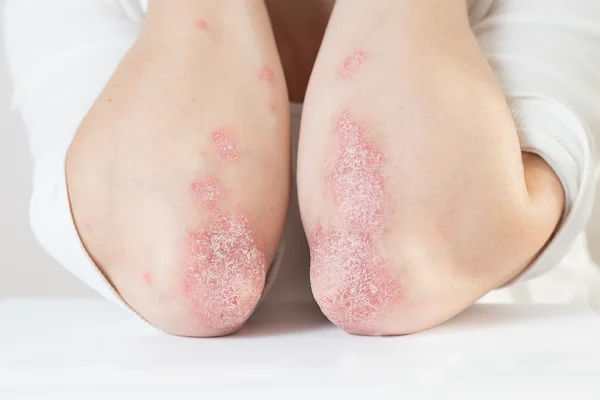Psoriasis on Back
Discover essential information about psoriasis on the back, including symptoms, causes, triggers, and treatment options like topical therapies, phototherapy, and biologics. Learn prevention tips to manage flare-ups effectively and improve your skin health

Written by Dr Sonia Bhatt
Last updated on 3rd Jul, 2025
Psoriasis is a common skin condition that can develop on various parts of the body, including the back, elbows, knees, scalp, face, palms, and soles of the feet. When it occurs on the back, it typically affects the lower back, which may cause significant discomfort. This can make sitting, wearing certain clothing, and moving around more challenging. The most common type of psoriasis affecting the lower back is plaque psoriasis, which accounts for 80% of all psoriasis cases.
In rare instances, a severe form of psoriasis called erythrodermic psoriasis may develop on the back. This form is extremely uncommon, comprising only 1 to 2.25% of cases. Unlike plaque psoriasis, erythrodermic psoriasis can cause widespread redness, shedding of skin, and severe pain, often requiring immediate medical attention. Recognizing the type of psoriasis is crucial for effective treatment and symptom management.
What Are the Symptoms of Psoriasis on the Back?
The symptoms of psoriasis can vary widely from person to person and often cycle between flare-ups and periods of remission. During a flare-up, symptoms may become more severe and disruptive.
For individuals with plaque psoriasis on the back, symptoms can range from mild to severe and may significantly impact daily life. Common symptoms include
Raised, thickened patches of skin (plaques)
Silvery, dry scales
Itching
Pain
Red or purple discolouration of the skin
Erythrodermic psoriasis is associated with intense and systemic symptoms, including:
Widespread skin discoloration
Severe pain
Intense itching
Shedding of large sheets of skin
Irregular heart rate
Fluctuations in body temperature
Dehydration
Noticeable changes in nails
Causes of Back Psoriasis
Symptoms often occur in cycles, with flare-ups lasting from weeks to months, followed by periods of remission. These flare-ups can be triggered by a variety of factors, which may differ from person to person. The most common triggers include:
Stress: Emotional or physical stress can worsen symptoms or bring on flare-ups.
Certain medications: Some drugs, such as those for high blood pressure or malaria, may trigger or worsen psoriasis.
Excessive alcohol consumption: Heavy drinking can lead to flare-ups or make existing symptoms more severe.
Skin injuries: Scrapes, cuts, rashes, or insect bites can cause psoriasis to appear or worsen in the affected area.
Getting a piercing or tattoo: The trauma to the skin from piercings or tattoos can trigger a flare-up.
Smoking: Smoking is a known trigger for psoriasis and can worsen symptoms.
Fluctuating weather: Rapid changes in temperature or humidity, especially from hot to cold, can trigger flare-ups.
Dry environments: Dry air can lead to skin dryness, exacerbating symptoms.
Extreme temperatures: Both hot and cold weather can trigger flare-ups.
Infections: Bacterial or viral infections, such as strep throat or respiratory infections, can lead to flare-ups, especially in children.
How Does Psoriasis on the Back Get Diagnosed?
To diagnose, your healthcare provider will examine the affected areas for typical signs of plaque psoriasis. They will also inquire about your symptoms, family history, and any recent changes in products or medications that might have triggered the flare-up. To rule out other potential conditions that could cause similar symptoms, such as eczema or dermatitis, they may conduct a series of tests, known as a differential diagnosis. These tests may include:
Allergy test: To determine if an allergic reaction is responsible for the skin issues.
Biopsy: A small sample of the affected skin may be taken to confirm psoriasis and exclude other conditions.
Blood tests: These tests help identify underlying causes of a rash that may not be related to plaque psoriasis, such as infections or other skin disorders.
What Are the Treatment and Management Options for Psoriasis on the Back?
The treatment for back psoriasis varies based on the severity of the condition and may involve a combination of therapies. Some common options include:
Topical creams: Applied directly to the skin, these creams help moisturize and alleviate pain and itching. While some are available over-the-counter, others may require a prescription.
Corticosteroids: These help reduce inflammation and control flare-ups.
Topical calcineurin inhibitors (TCIs): These medications reduce inflammation and are often used for sensitive areas of the skin.
Retinoids: These regulate the growth of skin cells and help reduce plaques.
Coal tar: It helps to reduce scaling and inflammation.
Anthralin: A topical treatment that slows the rapid turnover of skin cells.
Vitamin D-based treatments: These help control skin cell production and reduce inflammation.
Zoryve (roflumilast): A newer topical treatment for psoriasis.
Vtama (tapinarof): Another topical option for managing psoriasis.
Phototherapy is a treatment that exposes the affected skin to UV light under the guidance of a healthcare provider, helping to slow down the production of skin cells and reduce psoriasis symptoms.
For more severe cases, systemic treatments may be prescribed when topical treatments and phototherapy are not effective. These include:
Immunosuppressant: Drugs like cyclosporine that suppress the immune system to reduce inflammation.
Disease-modifying anti-rheumatic drugs (DMARDs): Medications like methotrexate that slow disease progression.
Biologics: Targeted medications such as infliximab that focus on specific immune system responses.
Phosphodiesterase-4 (PDE4) inhibitors: Drugs like apremilast that help manage inflammation and reduce excessive skin cell production.
How Can I Prevent Psoriasis on the Back?
Managing psoriasis on your back involves taking proactive steps to reduce flare-ups and keep your skin comfortable. Here are some effective strategies:
Identify and avoid triggers: Recognize and stay away from factors that can trigger flare-ups.
Moisturize regularly: Keep your skin hydrated to reduce dryness and itching.
Protect from UV light: Use sunscreen to shield your skin from harmful ultraviolet rays.
Soak in an oatmeal bath: This can help soothe irritation and relieve itching.
Manage stress: Practice mindfulness, relaxation exercises, or seek psychotherapy to reduce stress.
Limit alcohol consumption: Cutting back on alcohol may help improve your condition.
Quit smoking: Smoking can exacerbate psoriasis, so quitting can provide benefits.
Shower after exercise: Sweat can worsen symptoms, so rinse off soon after working out.
Choose appropriate clothing: Wear soft, comfortable, loose-fitting, and breathable clothes to avoid irritating your skin.
Adjust your sleeping position: If your psoriasis patches rub against your bedding, try sleeping on your side or stomach.
Opt for psoriasis-friendly bedding: Use sheets made from bamboo or cotton to reduce irritation.
Use sunscreen: Apply a waterproof, SPF 30+ sunscreen before heading outdoors to protect your skin from sun damage.
Conclusion
Psoriasis patches on your back are not contagious, meaning they cannot be spread to others through physical contact. While they typically don't indicate a serious underlying health problem, they can lead to significant discomfort. This is particularly true when trying to get a restful night's sleep or when sitting for extended periods. The discomfort may arise from itching, pain, or pressure on the affected areas, making everyday activities more challenging.
It’s important to consult a dermatologist, to manage your symptoms. They can offer personalized treatment options and also guide you in managing your condition over time, offering strategies to reduce the frequency of flare-ups and improve your overall quality of life.
Consult Top Dermatologists
Consult Top Dermatologists

Dr Shruti Kharbanda
Dermatologist
5 Years • MD, MBBS
Delhi
Apollo Hospitals Indraprastha, Delhi
(25+ Patients)

Dr Gayatri Rajesh
Dermatologist
12 Years • MBBS., DDVL
Chennai
Apollo Medical Centre Kotturpuram, Chennai

Dr. Antoinetta Ashwini
Dermatologist
5 Years • MBBS, MD- Derma
Chennai
Apollo Hospitals Heart Centre Thousand Lights, Chennai

Dr. Pranoti Deshpande
Dermatologist
5 Years • MBBS, MD (Dermatology, Venereology and Leprosy)
Hyderabad
Apollo Hospitals D R D O kanchanbagh, Hyderabad
(150+ Patients)

Dr. Sajai Varghese
Dermatologist
15 Years • MBBS, MD (DVIL), FAGE, FDLS
Chennai
Apollo First Med Hospitals P H Road, Chennai
(200+ Patients)


